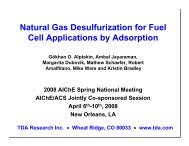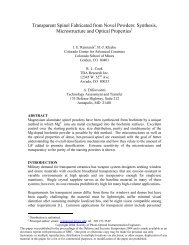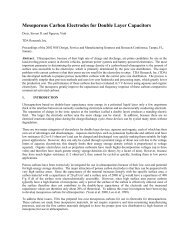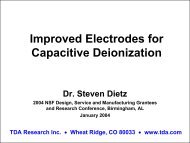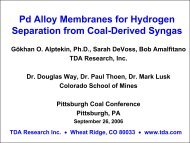Sorbents for Natural Gas Desulfurization - TDA Research, Inc.
Sorbents for Natural Gas Desulfurization - TDA Research, Inc.
Sorbents for Natural Gas Desulfurization - TDA Research, Inc.
Create successful ePaper yourself
Turn your PDF publications into a flip-book with our unique Google optimized e-Paper software.
Effect of MoistureThe presence of water reduced the sulfur adsorption capacity of all sorbents. Thecapacity of the zeolite-X is reduced the most by approximately 83%, showing zeolite-X’shigh affinity <strong>for</strong> the water vapor. The water most likely adsorbs on the surface of thesites, competing with the sulfur. It is worth noting that Yang and his coworkers saw asimilar reduction <strong>for</strong> copper exchanged Y zeolite, which lost 75% of its breakthroughcapacity in the presence of 300 ppmw H 2 O (4). Activated carbon had minimal drop incapacity in the presence of water, but its dry capacity was an order of magnitude lowercapacity than <strong>TDA</strong>’s SulfaTrap TM -R3. As shown in Table 3, the capacity of theSulfaTrap TM -R3 sample is also reduced in the presence of 50 ppmv water vapor.However, the competition with water vapor was less of a problem (only 24% dropcompared to 83% <strong>for</strong> commercial zeolite) <strong>for</strong> the SulfaTrap TM -R3 sorbent, and its drycapacity was approximately 800% better than that of zeolite X, and 1600% better thanactivated carbon.Table 3. Effect of moisture on various sorbents.SampleDryCapacityWetCapacityPercentCapacity Loss<strong>TDA</strong>’s SulfaTrap TM -R3 Sorbent 3.1% 2.4% 24%Grace X Zeolite 0.36% 0.06% 84%Norit RGM3 Activated Carbon 0.18% 0.17% 2.3%Concentration (ppmv)16014012010080604020050 ppmv H2O350 ppmv H2O1000 ppmv H2O0 100 200 300 400 500 600Time (min)Figure 4. The effect of moisture level on DMS adsorption in <strong>TDA</strong>’s SulfaTrap TM -R3Sorbent. T= 22 o C, P= 5 psig, <strong>Natural</strong> gas with 46 ppmv DMS at 60,000 h -1 .We analyzed the effect of increased levels of moisture on SulfaTrap TM -R3. FromFigure 4 we see that as the moisture content in the natural gas stream increases from 50 to350 ppmv the DMS breakthrough point does not change but the shape of thebreakthrough curve does change. The DMS wave front is sharp and the breakthroughcurve goes over the inlet DMS concentration of 46 ppmv. This “roll over“ is widely seenin the breakthrough curves of multicomponent feed mixtures and is a result ofcompetitive adsorption of water and DMS. Water adsorption wave front sweeps throughthe bed and it desorbs some of the adsorbed DMS giving rise to the roll over. As weincrease the moisture level further to 1000 ppmv the DMS breakthrough capacity dropsby 30%. The breakthrough capacities are reported in Table 4. This shows that moisture5




